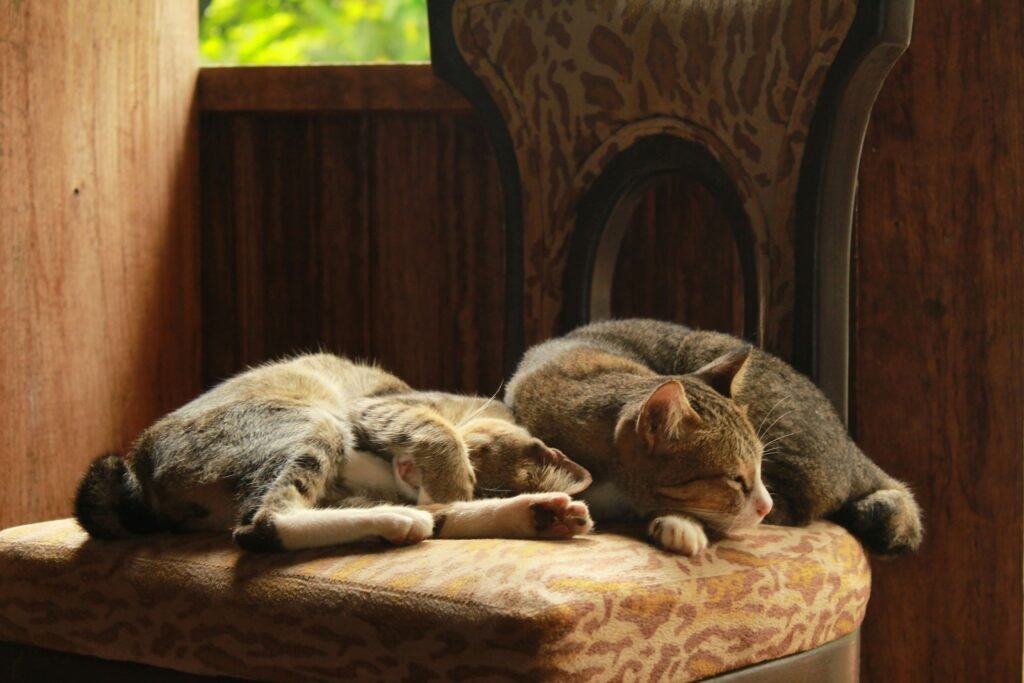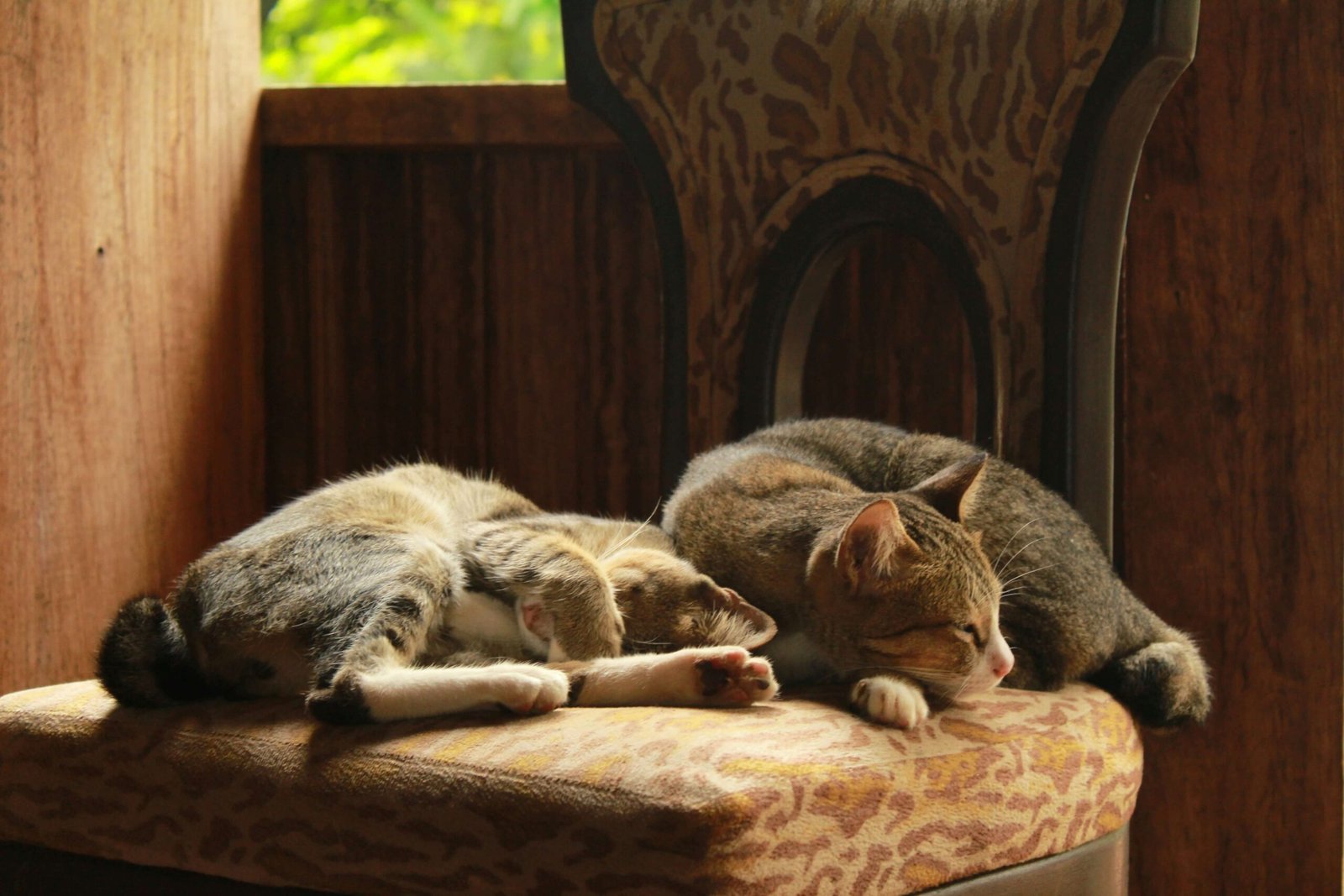Decoding the Secrets of Cat Sleeping Positions
Cats are fascinating creatures, and their sleeping habits are no exception. Whether curled up in a tight ball or sprawled out like a furry starfish, our feline friends seem to have an endless repertoire of sleeping positions. But did you know that these positions can reveal a lot about your cat’s mood, health, and even personality? Understanding what each position means can help you connect with your pet on a deeper level and ensure they’re happy and healthy. So, let’s dive into the world of cat sleeping positions and uncover what they truly signify.
Common Cat Sleeping Positions and Their Meanings
Cats spend a significant portion of their lives sleeping—up to 16 hours a day! During this time, they adopt various positions, each with its own unique meaning. Here’s a breakdown of some common sleeping postures and what they might indicate about your cat’s well-being:
The Loaf Position
When your cat tucks its paws under its body and sits upright like a loaf of bread, it’s often a sign of relaxation and contentment. This position allows them to stay alert while still conserving energy.The Curled-Up Ball
A cat curled tightly into a ball is likely trying to conserve body heat. This position also provides a sense of security by protecting their vital organs.The Side Sleeper
Cats lying on their side with their legs extended are showing complete trust and comfort. This position leaves them more vulnerable, so it’s a good indicator that they feel safe in their environment.The Belly-Up Pose
If your cat is sprawled out on its back with its belly exposed, it’s a clear sign of trust and relaxation. However, be cautious—this doesn’t always mean they want a belly rub!The Sphinx Pose
Named after the ancient Egyptian statue, this position involves the cat lying down with its front legs stretched forward and its head raised. It’s a mix of alertness and restfulness, often seen when they’re keeping an eye on their surroundings.
Understanding these positions can give you valuable insights into your cat’s emotional state and overall health. Pay attention to any sudden changes in their preferred sleeping style, as this could signal underlying issues.
What Your Cat’s Sleep Habits Reveal About Their Personality
A cat’s sleeping habits aren’t just about physical comfort—they also reflect their personality traits. By observing how your cat sleeps, you can learn more about their temperament and preferences. Here’s what different sleep behaviors might tell you:
Frequent Nappers
Cats who take multiple short naps throughout the day tend to be energetic and playful. They use these power naps to recharge for their next adventure.Long Sleepers
On the other hand, cats that prefer long stretches of uninterrupted sleep may be more laid-back and easygoing. These felines enjoy taking life at a slower pace.Hiding While Sleeping
If your cat frequently hides under furniture or blankets while sleeping, it could indicate shyness or anxiety. Providing a cozy, enclosed bed can make them feel more secure.Sleeping Near You
Cats that choose to sleep close to their owners are expressing affection and trust. This behavior shows they see you as part of their “pack.”Changing Spots Often
Some cats like to switch up their sleeping spots regularly. This curiosity-driven habit suggests they’re adventurous and love exploring new environments.
Your cat’s sleeping habits are a window into their inner world. By paying attention to these patterns, you can better understand their unique personality and strengthen your bond with them.
Check this guide 👉Top 5 Ultimate Cat Beds for Supreme Feline Comfort!
Check this guide 👉Top 5 Ultimate Cat Hammocks for Supreme Feline Comfort!
Check this guide 👉Top 4 Best Cat Sofas for Ultimate Feline Comfort!

Sleeping Position | Possible Meaning |
|---|---|
The Loaf | Relaxed but ready to spring into action |
The Curled-Up Ball | Seeking warmth and protection |
The Side Sleeper | Feeling safe and trusting |
The Belly-Up Pose | Complete relaxation and trust |
The Sphinx Pose | Alert yet resting |
How Environmental Factors Influence Cat Sleeping Positions
While personality plays a role, external factors such as temperature, noise levels, and available space can significantly impact how your cat chooses to sleep. Let’s explore how these elements shape their sleeping behavior:
Temperature Changes
In colder weather, cats are more likely to curl up tightly to retain body heat. Conversely, in warm environments, they’ll stretch out to cool down.Noise Levels
Loud or unpredictable noises can cause stress, leading cats to adopt defensive positions like the curled-up ball or hiding entirely.Space Availability
Limited space might force cats into compact positions like the loaf, while ample room encourages sprawling poses like the side sleeper.Comfort of Bedding
Soft, plush beds invite cats to relax fully, often resulting in open positions like the belly-up pose. Hard surfaces may lead to more guarded postures.Presence of Other Pets
Multi-pet households can influence sleeping positions based on social dynamics. Dominant cats may claim high, visible spots, while submissive ones hide away.
By considering these environmental influences, you can create a harmonious space that supports your cat’s natural sleeping tendencies.
Health Indicators Through Cat Sleeping Patterns
Changes in your cat’s sleeping positions can sometimes point to health concerns. Keep an eye out for unusual shifts that might warrant a visit to the vet:
Excessive Lethargy
If your normally active cat suddenly starts sleeping excessively, it could indicate illness or pain.Avoidance of Certain Positions
Refusing to lie on one side or avoiding the belly-up pose might suggest discomfort or injury.Restlessness During Sleep
Constant tossing and turning can be a sign of stress, arthritis, or digestive issues.Unusual Hiding Behavior
Cats that suddenly start hiding while sleeping may be feeling unwell or anxious.Snoring or Labored Breathing
New sounds during sleep could indicate respiratory problems or weight-related issues.
Monitoring these signs can help you catch potential health problems early and ensure your cat receives timely care.
Emotional States Reflected in Cat Sleeping Positions
A cat’s sleeping position can often mirror their emotional state, offering clues about whether they’re feeling happy, anxious, or even bored. Paying attention to these subtle cues can help you address their needs more effectively. Here are some examples of how emotions influence their sleep posture:
Happy and Relaxed
Cats that feel safe and content are more likely to stretch out fully or expose their belly. These positions indicate a high level of trust and relaxation.Anxious or Stressed
When cats are feeling uneasy, they may curl up tightly or hide while sleeping. This behavior helps them feel protected and less vulnerable.Bored or Restless
Cats that frequently change positions or toss around during sleep might be seeking stimulation or mental engagement during their waking hours.
Understanding these emotional signals allows you to create a nurturing environment that supports your cat’s mental well-being. A happy cat is more likely to thrive, and recognizing these signs is the first step toward ensuring their happiness.
Seasonal Variations in Cat Sleeping Habits
Cats are highly adaptable creatures, and their sleeping positions often shift with the changing seasons. Temperature, daylight hours, and seasonal energy levels all play a role in how your cat chooses to rest. Below are some seasonal patterns you might notice:
Winter Sleep Patterns
During colder months, cats tend to curl up tightly to conserve body heat. You might also find them seeking warmer spots near heaters or sunlight.Summer Sleep Adjustments
In warmer weather, cats sprawl out to cool down. They may avoid direct sunlight and opt for cooler surfaces like tiles or shaded areas.Spring and Fall Transitions
As temperatures fluctuate during transitional seasons, cats may alternate between compact and stretched-out positions depending on the weather.
These seasonal changes are natural and reflect your cat’s ability to adapt to their environment. Providing cozy blankets in winter and cool resting spots in summer can help them stay comfortable year-round.
Bonding Through Observing Sleeping Behaviors
Observing your cat’s sleeping habits isn’t just about understanding their health—it’s also an opportunity to strengthen your bond. By paying attention to their preferences and routines, you can build trust and create a deeper connection. Here’s how observing their sleep can enhance your relationship:
Learning Their Preferences
Noticing where and how your cat likes to sleep can help you tailor their environment to their liking, making them feel more at home.Recognizing Trust Signals
Positions like the belly-up pose or sleeping near you are clear signs of trust. Acknowledging these moments fosters mutual affection.Identifying Stress Early
Being attuned to changes in their sleeping behavior allows you to address potential stressors before they escalate, showing your cat you care.
By taking the time to observe and interpret your cat’s sleeping behaviors, you’re not only ensuring their well-being but also nurturing a lifelong bond built on love and understanding. After all, a happy cat makes for a happy household.
Frequently Asked Questions About Cat Sleeping Positions
Why does my cat sleep so much?
Cats are naturally crepuscular animals, meaning they’re most active during dawn and dusk. The rest of the time, they conserve energy through sleep.
Is it normal for my cat to change sleeping positions often?
Yes, cats adapt their sleeping positions based on comfort, temperature, and mood. Occasional changes are normal.
Should I worry if my cat sleeps all day?
Not necessarily, as long as they’re eating, drinking, and behaving normally. However, consult a vet if there’s a drastic increase in sleep duration.
Does my cat’s sleeping position affect its health?
While occasional awkward positions are harmless, consistently uncomfortable postures could indicate underlying issues.
Can I train my cat to sleep in a specific spot?
With patience and positive reinforcement, you can encourage your cat to favor certain areas, though their preference ultimately depends on comfort.
Understanding Your Feline Friend Through Their Sleep
From the adorable loaf to the regal sphinx pose, every sleeping position tells a story about your cat’s emotions, health, and personality. By observing and interpreting these cues, you can deepen your connection with your furry companion and provide them with the care they need. Remember, every cat is unique, so embrace their quirks and enjoy the journey of understanding their mysterious ways. After all, there’s nothing quite like sharing your home with a creature as enchanting as a cat.
Canned Pumpkin for Cat Diarrhea: Best 7 Expert Tips! Natural remedy to firm stools, soothe upset bellies, and support gut health safely.
Can a Cat Give You Scabies? Best 7 Expert Tips! Discover the truth about feline mites, human skin risks, and how to protect yourself—without panic.
Cat Flea vs Human Flea: Best 7 Expert Tips! Discover the truth about bites, species, and how to eliminate infestations for good.
Weird Cat Behaviors: Best 7 Expert Tips! Discover why cats do strange things—and how to understand, not punish, their instincts for a happier home.





